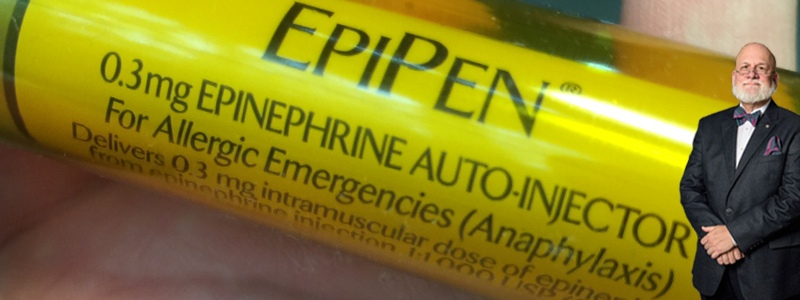If you need epinephrine in case of allergic reaction emergencies you probably think you have just one, expensive option – the prefilled autoinjector devices, aka the EpiPen.
There is no question these devices save lives, but their limited shelf life and outrageous cost make them almost out of reach – especially when you need to keep several on hand; home, automobile/purse, school, and so on. At the present, the EpiPens are available in packages of two with a cost north of $500.00. Insurance copays have been rising along with the cost of the pens. Conscientious people are looking for alternatives – ones that have better shelf life and lower cost. Even emergency departments are lowering costs by replacing the EpiPens.
Understand that epinephrine is epinephrine regardless of what kind of container it’s in – auto injector, vial, ampoule. The pen devices have a much shorter expiration than epinephrine in the vial. Once opened or exposed to air, the activity of epinephrine call fall fairly quickly. It can also become contaminated more quickly when a needle is inserted into the vial, but not in the brief time the vial is being used – even if multiple doses are removed for one treatment. To be perfectly safe, a user would want to discard any remaining epinephrine after the anaphylactic crisis has passed.
The auto injector is convenient, but is the time it saves all that important? It is vital to recognize the reaction and take action as soon as possible. Preparing an auto injector is probably quicker than popping the top on a vial, inserting a syringe, inverting the vial, and pulling out the correct amount. Sterility is not an issue in an emergency at the point when the injection is made – even through clothes.
There are practice auto injectors so users can become familiar with preparing the device and doing the injection. In a like manner, those who will depend on an epinephrine injection can obtain sterile vials of water or saline with which to practice. Multiple people can practice with one inexpensive vial of water and a few syringes. I suggest it would be easy to prepare anyone – maybe everyone – who may have to administer an emergency dose of epinephrine; parents, patients, teachers, law enforcement, and so on.
Can you request a prescription for vial from your doctor? A doctor could certainly prescribe a vial when he/she is confident the parent/patient knows how to draw up the dose and administer. The important thing is the dose of epinephrine, not the elegance of the injection device.
How would insurance process this versus the pen? Why worry about insurance? First, they ought to happily cover all of the cost of the vials and syringes – their main duty. Regardless, the cash price of the vial/syringe is a tenth the cost of pens and probably less than the copay. Cash has long been king.
Can you carry the vial in your purse (similar to how diabetics carry insulin)? Yes, the vial and a couple of syringes are no larger or more cumbersome than the pre-filled pen.
Is there a temperature requirement for the vial to stay active? Epinephrine in the vial is the same as the epinephrine in the pen. No refrigeration needed for pen applies to the vial as well.
It is possible drug makers could find ways to lower the cost of the auto injector epinephrine devices? Unless there is an alternative that is far less costly and doesn’t increase the risk to the patient, that is still an unknown. Consider talking to your doctor about using a vial and syringes. There is no reason identical emergency treatments should be so different in cost – unless you believe the marketing hype from the makers of the auto injector devices.

